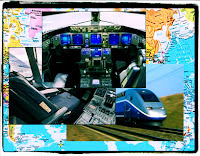If Fish Could Draw II: Reflecting Spheres and the Search for Old Paintings
 In September 2009 I blogged about how the limitations of one media often drive creativity in another (If Fish Could Draw, 28 September 2009). One of the examples I gave was the art of Catarina Kruusval , whose illustrations are sometimes drawn with distorted verticals and perspective like the view from a fisheye lens. I am still convinced that she was inspired by wide angle lenses but it turns out I was rash to say that this view had never been seen until such lenses were invented.
In September 2009 I blogged about how the limitations of one media often drive creativity in another (If Fish Could Draw, 28 September 2009). One of the examples I gave was the art of Catarina Kruusval , whose illustrations are sometimes drawn with distorted verticals and perspective like the view from a fisheye lens. I am still convinced that she was inspired by wide angle lenses but it turns out I was rash to say that this view had never been seen until such lenses were invented.
Artists have, in fact, been looking at this kind of perspective since they first made metal spheres shiny enough to reflect a wide angle image. There is a famous picture of MC Escher holding a shiny sphere in his hand and observing the reflected image; he used this sphere in the 1920’s and 1930’s to make woodcuts and lithographs where he was at the center. I will be very surprised if nobody thought of this before Escher.
One earlier example is a photograph taken in 1910 by an unknown amateur photographer and included in Michel Frizot’s outstanding “Nouvelle Histoire de la Photographie”, a must-have volume for photography fans. The photographer stands in front of a polished metal sphere and is at the center of the resulting wide angle photo, taken long before fish eye lenses were invented. I left the entire image so that you can see the sphere, but if you crop the image you get the typical fisheye view.
Almost certainly other artists in earlier periods must have noticed the strange reflections in metal spheres so now I wonder who was the first to actually use this perspective in a painting or drawing? I am going to check again all the galleries and art books I can find, looking for early examples. If you happen to see one yourself please add a comment or mail me. When I find something I will post another update.
UPDATE, 15 August 2013: Thanks to Quora I have found a painting by Jan Van Eyck, the Arnolfini Portrait, that includes in the background a reflection in a convex mirror that is clearly a precise fisheye view. This was painted in 1434.



Comments